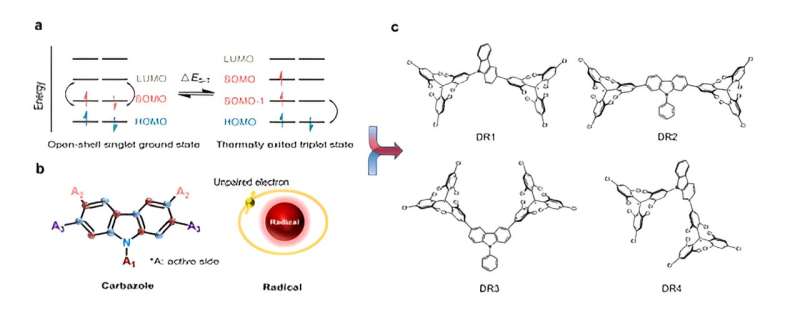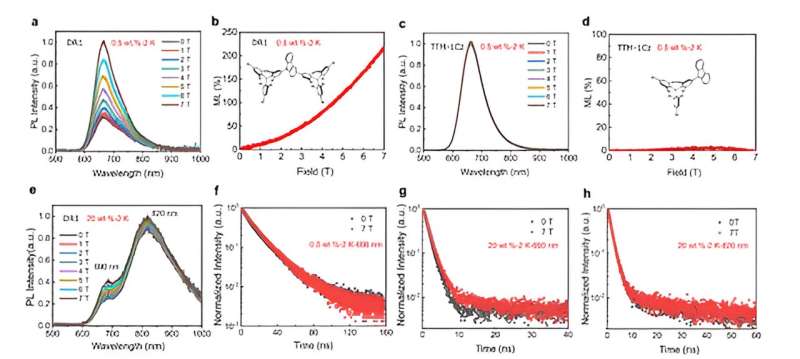This article has been reviewed according to Science X's editorial process and policies. Editors have highlighted the following attributes while ensuring the content's credibility:
fact-checked
peer-reviewed publication
trusted source
proofread
A highly efficient open-shell singlet luminescent diradical with strong magnetoluminescence properties

Open-shell singlet (OS) diradicals are important building blocks for functional molecular materials, with a large number of pioneering works by researchers advancing their development and applications across various fields. Despite this progress, there remains a lack of research regarding luminescent OS diradicals, hindering their potential use in optoelectronic applications. In fact, the luminescent diradicals are rare chemical species, there are only a few reports to date.
Magnetic field effects (MFE) on the luminescence, i.e., magnetoluminescence (ML) of radicals, hold great promise for developing novel exciton spin manipulation methodologies that are unachievable by conventional closed-shell luminescent molecules.
In 2018, Kusamoto and co-workers first reported MLs in organic radical excimer species, which opened the gate to this field. However, the development of highly luminescent diradicals and the achievement of their efficient single-molecule ML properties continue to be a formidable challenge.
In a new paper published in Light: Science & Applications, Professor Alim Abdurahman from the College of Electronic Science and Engineering of Jilin University, China, and co-workers have proposed a concept to enhance luminescent efficiency by adjusting the donor conjugation of OS diradicals, thereby achieving a highly luminescent diradical, DR1, with outstanding stability, and making it a viable option for use in the emitting layer of organic light-emitting diodes (OLEDs).
More importantly, the 0.5 wt.%-DR1 doped film demonstrates significant single-molecule magnetoluminescence (ML) properties. A giant ML value of 210% is achieved at a magnetic field of 7 T, showing the great potential of DR1 in magneto-optoelectronic devices.

"Following the theoretical framework above, we select carbazole, a mild donor unit with a non-alternating molecular structure and multiple active sites as the bridging group, and tris(2,4,6-trichlorophenyl)methyl (TTM) as the radical center to design four diradicals, DR1–DR4, The calculation results indicate that DR1 exhibits the most efficient electron-hole separation and higher oscillator strength for the first excited state transitions than the other three diradicals."
"We report herein a highly efficient OS luminescent diradical DR1, which was prepared in four steps from commercially available reagents. Both experimental and calculation results suggest that DR1 is an OS in the ground state and the triplet state is thermally accessible due to rather small singlet-triplet energy gap. DR1 also exhibits high photoluminescence property and photo-stability."
"It is interesting to find that DR1 shows quite strong ML properties. The PL intensity of DR1 single-molecule (0.5 wt.%) significantly enhances with the increase in magnetic field (from 0 to 7 T) at 2 K, achieving a giant ML value of 210% at 7 T. In contrast, the mono-radical TTM-1Cz (0.5 wt%) exhibits almost no ML effect. This indicates that the interaction between two electrons within a single-molecule of DR1 plays a key role for MLs."
More information: Alim Abdurahman et al, A highly efficient open-shell singlet luminescent diradical with strong magnetoluminescence properties, Light: Science & Applications (2023). DOI: 10.1038/s41377-023-01314-z
Journal information: Light: Science & Applications
Provided by Chinese Academy of Sciences





















